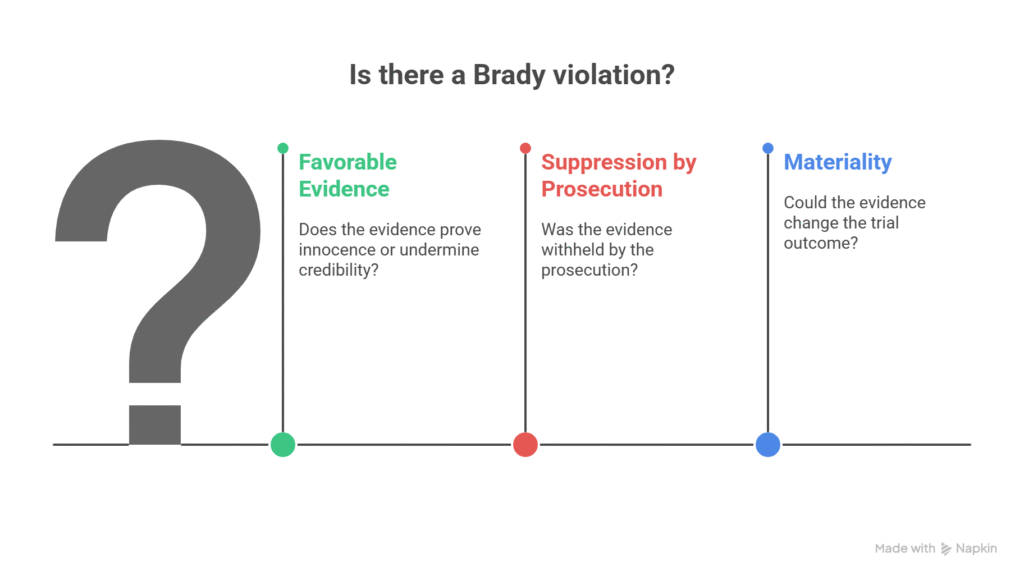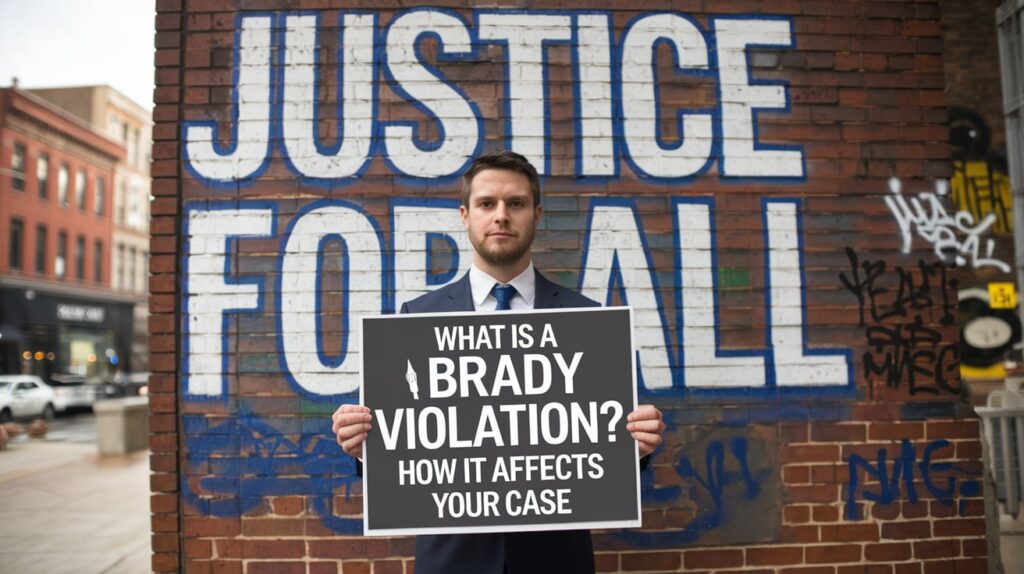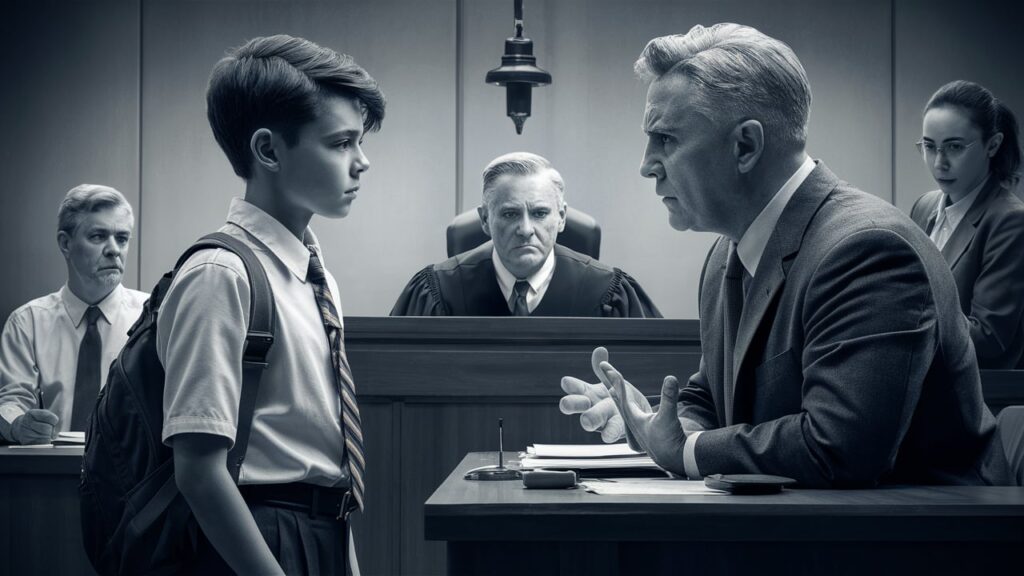Have you ever wondered how certain pieces of evidence can make or break a legal case? Imagine you’re in the midst of a legal battle, and there’s crucial information that could completely change the outcome of your case.
This is where the concept of a “Brady Violation” comes into play. But what exactly is a Brady Violation, and why should you care about it? In the world of law, a Brady Violation can significantly impact your case’s trajectory, potentially even deciding its outcome.
It involves the withholding of evidence that could be vital to your defense. This isn’t just a legal technicality; it’s a fundamental issue that can determine whether justice is truly served. Understanding Brady Violations could be the key to unlocking a fair trial and ensuring that all relevant facts come to light. Curious about how this could affect your case? Ready to uncover the ins and outs of this critical legal concept? Dive deeper into this article and arm yourself with the knowledge that could make all the difference in your legal journey.
Brady Violation Basics
Understanding the basics of a Brady Violation is crucial if you ever find yourself tangled in legal proceedings. Named after a landmark Supreme Court case, Brady v. Maryland, this term refers to a vital aspect of the justice process that can significantly impact your case. But what does it really mean when someone talks about a Brady Violation? Here, we’ll break it down for you, starting with its origin and definition, followed by the key elements that make it up.
Origin And Legal Definition
The concept of a Brady Violation stems from the 1963 Supreme Court case, Brady v. Maryland. The court ruled that withholding evidence favorable to the defendant by the prosecution violates due process. This decision established the legal requirement for prosecutors to disclose any exculpatory evidence. Exculpatory evidence is any information that may prove the innocence of the defendant or reduce their liability.
Imagine discovering crucial evidence that could have turned your case around, but was never shared by the prosecution. This is a Brady Violation. It underlines the principle that justice should be fair and transparent. Have you ever considered how much trust is placed in the legal system to ensure fairness?
Key Elements
For a Brady Violation to occur, three key elements must be present. First, the evidence in question must be favorable to the defendant. This means it could aid in proving innocence or lessen the severity of the charges. Second, the evidence must be suppressed by the prosecution, whether intentionally or unintentionally. Finally, the suppression of evidence must be material, meaning it has a reasonable probability of affecting the outcome of the trial.
Picture a scenario where a piece of evidence showing you were miles away from the crime scene is withheld. Such evidence could drastically alter the verdict. This highlights why understanding Brady Violations is essential for anyone involved in legal cases. Have you ever wondered how often crucial evidence is overlooked in trials?
-
Favorable Evidence: The evidence must be exculpatory (proving innocence) or impeaching (undermining prosecution witnesses’ credibility).
-
Suppression by Prosecution: The evidence was withheld, intentionally or unintentionally, by the prosecution or law enforcement.
-
Materiality: The evidence is significant enough that its absence creates a reasonable probability of a different trial outcome.

Knowing these elements can empower you to ask the right questions and ensure that justice is served fairly in your case. It’s not just about knowing your rights; it’s about ensuring they are upheld in every step of the legal process. How prepared are you to safeguard your interests?
Examples Of Brady Violations
Brady violations are serious breaches in legal proceedings. They occur when prosecutors fail to disclose evidence. This can affect the outcome of a case. Understanding these violations is crucial. Below are some key examples:
Suppression Of Evidence
Suppression of evidence is a common Brady violation. Prosecutors might hide evidence that could help the defense. This could include witness statements or forensic reports. Such actions can lead to wrongful convictions. It undermines the fairness of the trial.
Failure To Disclose Exculpatory Evidence
Exculpatory evidence can prove innocence. Not sharing this evidence is a Brady violation. It can impact a defendant’s right to a fair trial. Examples include alibi witnesses or surveillance footage. Such omissions skew the trial process. They lead to unjust outcomes.
Misleading Information
Providing misleading information is another Brady violation. Prosecutors may present false or deceptive data. This can mislead the jury or judge. It affects the integrity of the justice system. Ensuring accurate information is vital for justice.
Legal Framework
The Brady rule stems from Brady v. Maryland, 373 U.S. 83 (1963), where the Supreme Court held that suppressing favorable evidence violates due process when it is material to guilt or punishment. Subsequent cases have refined the rule:
-
United States v. Agurs (1976):
-
Clarified that the duty to disclose applies even without a defense request and includes evidence that could create reasonable doubt.
-
-
United States v. Bagley (1985):
-
Established the “materiality” standard: Evidence is material if there is a reasonable probability its disclosure would have changed the trial’s outcome.
-
-
Kyles v. Whitley (1995):
-
Held that prosecutors must disclose evidence held by law enforcement or other government agents, not just evidence in their direct possession.
-
Emphasized the cumulative impact of withheld evidence.
-
-
Strickler v. Greene (1999):
-
Reinforced that unintentional suppression still constitutes a violation if the evidence is material.
-
-
Banks v. Dretke (2004):
-
Confirmed that Brady applies to impeachment evidence, such as undisclosed deals with prosecution witnesses.
-
The Brady rule is enforced under federal law (U.S. Constitution, Amendments V and XIV) and applies to all state and federal criminal prosecutions. Some states have stricter disclosure laws, such as California’s Pitchess v. Superior Court (1974), which governs police personnel records.
How a Brady Violation Affects Your Case
A Brady violation can significantly impact a criminal case, potentially leading to overturned convictions, retrials, or reduced sentences. Its effects depend on the stage of the case and the nature of the withheld evidence.
During Trial
-
Discovery of Violation: If the defense uncovers a Brady violation during trial (e.g., through witness testimony revealing withheld evidence), they can request a mistrial or continuance to review the material.
-
Impact: Courts may admit the evidence, exclude tainted testimony, or declare a mistrial if the violation prejudices the defense.
Post-Trial (Appeal or Post-Conviction)
-
Motion for New Trial: If a violation is discovered after conviction, the defense can file a motion for a new trial under Rule 33 of the Federal Rules of Criminal Procedure or state equivalents (e.g., Cal. Penal Code § 1181).
-
Habeas Corpus: Federal habeas petitions (28 U.S.C. § 2255) or state habeas relief can be sought if the violation undermines the conviction’s fairness.
-
Impact: Courts may:
-
Overturn the conviction if the evidence could have reasonably altered the verdict (Kyles v. Whitley).
-
Order a new trial with the disclosed evidence.
-
Reduce the sentence if the evidence affects sentencing but not guilt.
-
Examples of Case Outcomes
-
Overturned Conviction: In Banks v. Dretke (2004), a death row conviction was reversed because prosecutors failed to disclose a witness’s informant status, undermining the trial’s fairness.
-
Retrial: In Giglio v. United States (1972), a new trial was granted after the prosecution withheld a deal with a key witness, violating Brady principles.
-
Dismissal: In rare cases, severe violations (e.g., intentional suppression) may lead to case dismissal, though courts typically prefer retrials.

Consequences for Prosecutors
-
Sanctions: Prosecutors may face professional discipline, such as bar sanctions, for intentional violations (In re Jordan, 2016).
-
Civil Liability: Rarely, prosecutors may face lawsuits for misconduct, though qualified immunity often applies (Connick v. Thompson, 2011).
-
Court Reprimands: Judges may issue findings of misconduct, impacting prosecutors’ reputations.
Impact On Legal Cases
A Brady Violation can greatly affect legal cases. It occurs when the prosecution fails to disclose evidence favorable to the defense. This can lead to unfair trials and wrongful convictions. Understanding its impact is crucial for anyone involved in legal proceedings.
Effect On Fair Trials
Brady Violations undermine the fairness of trials. They prevent defendants from accessing important evidence. This evidence could help prove innocence or reduce penalties. Without it, defendants face a significant disadvantage. The justice system relies on fair trials. Brady Violations damage this principle.
Consequences For Convictions
Wrongful convictions can result from Brady Violations. Hidden evidence might reveal a defendant’s innocence. If not disclosed, guilty verdicts may be unjust. Convictions based on incomplete information are unreliable. Ensuring all evidence is shared is vital for accurate judgments.
Role In Appeals
Brady Violations play a critical role in appeals. Defendants can appeal based on withheld evidence. Courts review if the violation affected the trial’s outcome. Successful appeals can lead to retrials or overturned convictions. It highlights the importance of transparency in legal cases.
Identifying Brady Violations
Understanding Brady violations is crucial in legal cases. A Brady violation occurs when the prosecution hides evidence that could help the defense. This can impact the fairness of a trial. Identifying these violations is vital for justice.
Recognizing the signs can protect the rights of the accused. Defense attorneys play a key role in spotting these issues. They ensure that all evidence is presented in court.
Signs In Legal Proceedings
Brady violations often hide important evidence. Look for missing or altered documents. Also, watch for witnesses who change their stories. These signs suggest that evidence is being withheld. The defense must act fast to uncover hidden details.
Sometimes, prosecution may delay sharing evidence. This can be a tactic to prevent the defense from preparing properly. Keep an eye on the timeline of evidence disclosure.
Role Of Defense Attorneys
Defense attorneys have a duty to seek justice for their clients. They must be vigilant in identifying Brady violations. This involves investigating the prosecution’s evidence thoroughly.
Attorneys should request all evidence from the prosecution. They should also interview witnesses and examine all case files. This helps ensure no evidence is left out.
Defense attorneys can file motions if they suspect a Brady violation. This legal step can compel the prosecution to release hidden evidence. Their role is crucial in maintaining a fair trial process.
Legal Remedies And Recourse
Understanding a Brady violation is crucial for legal cases. A Brady violation occurs when prosecution fails to disclose evidence favorable to the defendant. This can significantly impact the fairness of a trial. Legal remedies and recourse exist to address such violations. These actions can help restore justice and fairness. Below are key legal avenues available for those affected by a Brady violation.
Filing For Retrial
One option is filing for a retrial. A retrial can be requested if undisclosed evidence could alter the verdict. The court reviews the new evidence to determine its impact. If the evidence is significant, a new trial may be granted. This process ensures the defendant receives a fair trial.
Appeal Process
Another legal remedy is the appeal process. Defendants can appeal their conviction if a Brady violation is discovered. Appeals challenge the original trial’s fairness due to undisclosed evidence. The appellate court examines the violation’s impact on the case. If the appeal succeeds, the conviction may be overturned.
Judicial Sanctions
Judicial sanctions can also address Brady violations. Sanctions hold the prosecution accountable for their misconduct. These can range from fines to professional discipline. Such measures emphasize the importance of fair legal proceedings. They deter future violations and uphold justice.
Preventive Measures
Understanding preventive measures can help avoid Brady violations. These measures ensure fairness in legal proceedings. Both prosecutors and defense attorneys have roles in preventing such violations. Clear guidelines and practices help maintain justice. Let’s explore these responsibilities further.
Prosecutorial Responsibilities
Prosecutors must disclose all evidence that favors the defense. This includes exculpatory evidence that could impact the outcome. They need to review all gathered information carefully. Sharing evidence with the defense is crucial. Failing to do so can lead to unfair trials. Prosecutors should keep records of shared evidence. This practice ensures transparency and accountability. Regular training on Brady obligations is also essential.
Defense Strategies
The defense team must actively seek favorable evidence. This involves requesting all relevant materials from prosecutors. Keeping communication open is vital. Defense attorneys should familiarize themselves with Brady requirements. They must be vigilant in identifying potential violations. Challenging any discrepancies is part of their role. Staying informed aids in protecting their client’s rights. Regular consultations with legal experts can be beneficial.
Real-world Cases
Understanding the real-world impact of a Brady violation is crucial. It can deeply affect legal proceedings and outcomes. Examining real-world cases provides insights into its consequences. These cases highlight the importance of fair trial practices and transparency. They also shed light on the judicial processes and their flaws.
Notable Case Studies
One infamous case is the O.J. Simpson trial. The defense accused the prosecution of hiding evidence. This allegation centered around DNA evidence and police conduct. It became a focal point of the trial, impacting public perception.
Another significant case involved Michael Morton. Morton was wrongfully convicted due to suppressed evidence. Prosecutors failed to disclose a key witness statement. This omission led to 25 years of wrongful imprisonment. Morton’s case emphasizes the devastating effects of Brady violations.
Lessons Learned
These cases teach us the value of transparency in justice. They highlight the need for accountability among legal professionals. Ensuring all evidence is shared can prevent wrongful convictions. This promotes trust in the judicial system and fairness in trials.
Real-world examples stress the importance of vigilance. They remind us to question and verify the integrity of legal processes. Learning from past mistakes can help improve future justice outcomes.
Practical Tips for Defendants
-
Demand Transparency: Request all discovery materials early, including police reports, witness statements, and forensic evidence.
-
Work with Experts: Forensic or legal experts can identify gaps in prosecution disclosures, strengthening Brady claims.
-
Know State Laws: Some states, like California, have broader discovery laws (e.g., Cal. Penal Code § 1054.1) that complement Brady obligations.
-
Preserve Evidence: Document all interactions with prosecutors to support claims of suppression.
-
Act Quickly: File motions promptly to avoid procedural bars on appeals or habeas petitions.
-
Seek Nonprofit Support: Organizations like the Innocence Project can assist with Brady claims in wrongful conviction cases.
Impact of Brady Violations in 2025
-
Increased Scrutiny: High-profile exonerations have led to stricter judicial oversight of prosecutorial conduct, with courts more willing to grant relief (Wearry v. Cain, 2016).
-
Legislative Reforms: States like California have expanded discovery laws (e.g., SB 94, 2023) to mandate broader evidence disclosure.
-
Technology’s Role: Digital evidence (e.g., body cam footage, metadata) has made Brady violations easier to uncover but also increases the volume of material prosecutors must review.
Frequently Asked Questions
What Is A Brady Violation?
A Brady violation occurs when the prosecution fails to disclose evidence favorable to the defendant. This non-disclosure can affect the fairness of the trial. It might lead to a wrongful conviction if crucial evidence is withheld. Understanding Brady violations helps ensure justice is served in legal proceedings.
How Does A Brady Violation Affect A Case?
A Brady violation can severely impact a case by undermining the defendant’s right to a fair trial. It can lead to overturned convictions and retrials. The withheld evidence might have changed the trial outcome. Ensuring all evidence is disclosed is crucial for maintaining justice and fairness.
Can A Case Be Dismissed Due To Brady Violation?
Yes, a case can be dismissed if a Brady violation is proven. Courts may dismiss if the withheld evidence is significant. It’s essential for ensuring justice and fairness in legal proceedings. The prosecution’s obligation to disclose all evidence is crucial for a fair trial.
Who Is Responsible For Proving A Brady Violation?
The defense is responsible for proving a Brady violation. They must show that the evidence was favorable and material. Demonstrating the impact of undisclosed evidence is crucial. The violation must be significant enough to affect the trial’s outcome. Legal representation helps navigate these complex situations.
Conclusion
Understanding Brady violations is crucial for a fair trial. These violations can impact your case significantly. They involve withholding evidence that might help your defense. This can lead to unjust convictions. Knowing your rights helps protect your case. Seek legal advice if you suspect a Brady violation.
An experienced lawyer can navigate these complex issues. They ensure fair treatment in court. Protect your rights actively. Stay informed on legal procedures. This knowledge can be vital. Your freedom depends on fair justice. Always demand transparency in your case.
It makes a difference.
References
- Brady v. Maryland, 373 U.S. 83 (1963).
- United States v. Agurs, 427 U.S. 97 (1976).
- United States v. Bagley, 473 U.S. 667 (1985).
- Kyles v. Whitley, 514 U.S. 419 (1995).
- Strickler v. Greene, 527 U.S. 263 (1999).
- Banks v. Dretke, 540 U.S. 668 (2004).
- Giglio v. United States, 405 U.S. 150 (1972).
- Pitchess v. Superior Court, 11 Cal. 3d 531 (1974).
- In re Jordan, 7 Cal. 5th 1138 (2016).
- Connick v. Thompson, 563 U.S. 51 (2011).
- Wearry v. Cain, 577 U.S. 385 (2016).
- Cal. Penal Code § 1054.1 (2025).
- Federal Rules of Criminal Procedure, Rule 33 (2025).
- 28 U.S.C. § 2255 (2025).
- California Senate Bill 94 (2023).
Disclaimer: The content on this page is for general information only and should not be considered legal advice. We work hard to provide accurate and up-to-date details, but we can't guarantee the completeness or accuracy of the information. Laws and rules change often, and interpretations may vary. For specific advice, always consult a qualified legal expert. We are not liable for any actions you take based on this information. If you spot any errors or outdated content, please contact us, and we’ll update it as soon as possible.


